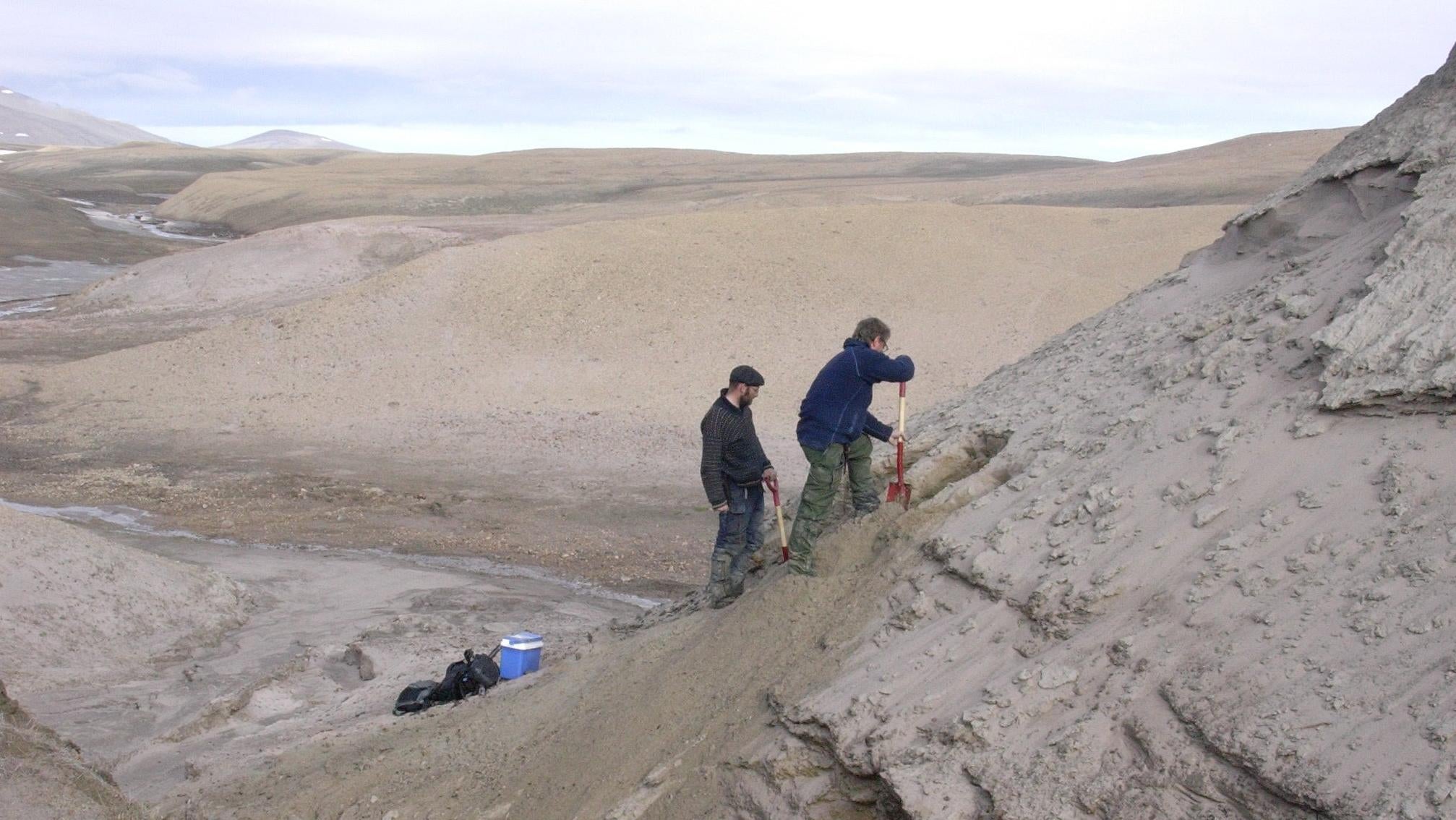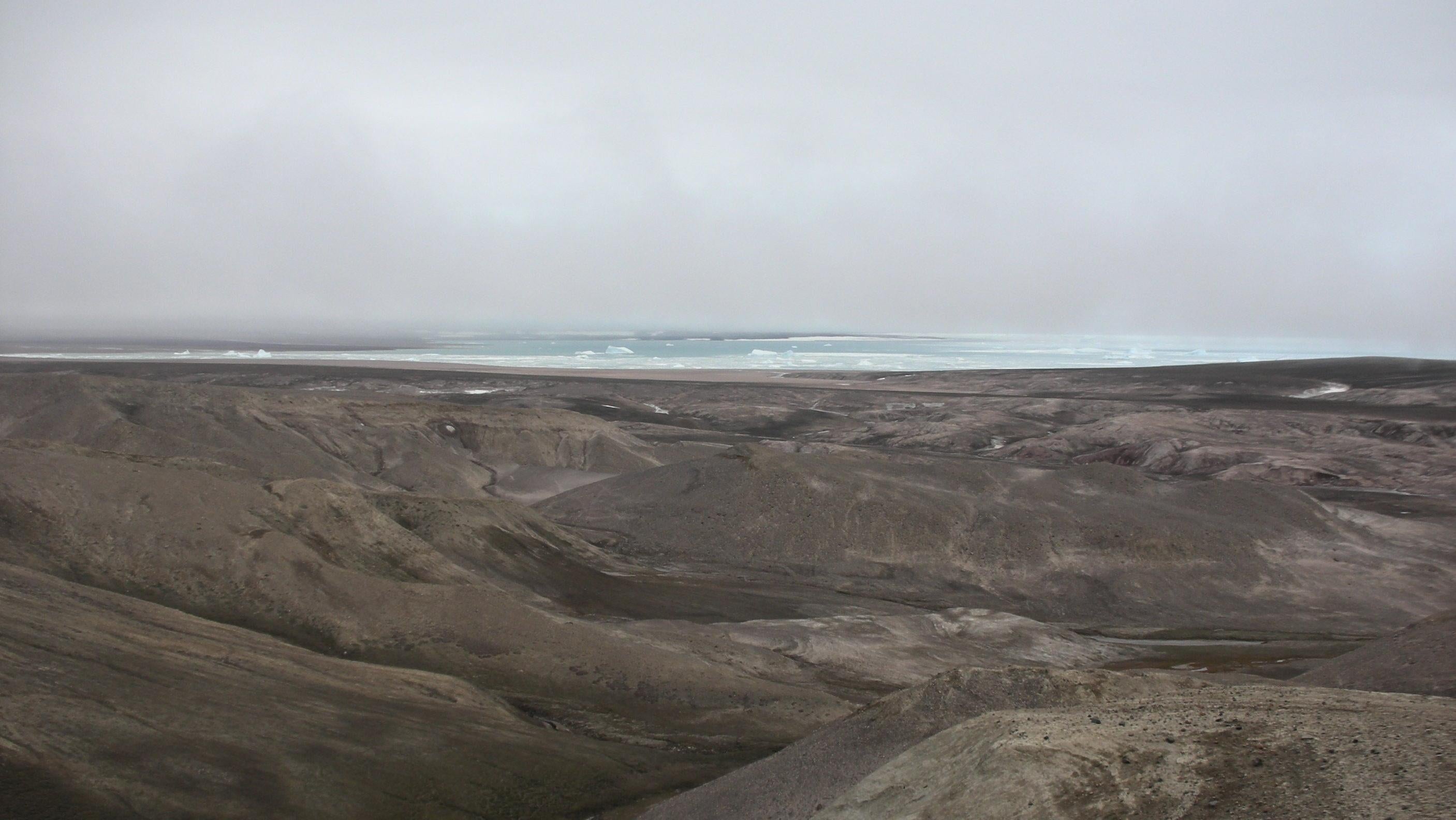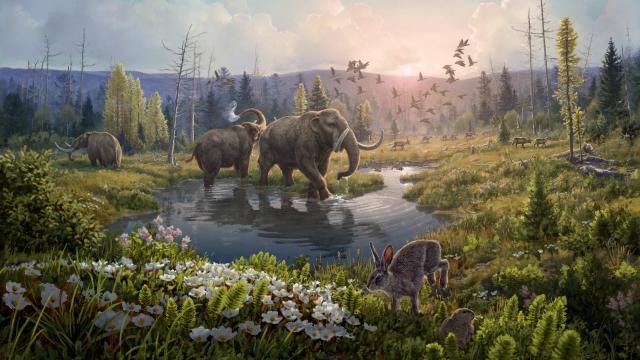A team of scientists sequenced the most ancient DNA yet, found in permafrost in the northernmost reaches of Greenland. The DNA is 2 million years old, blowing past the previous record for the most ancient DNA by a million years.
The genetic material came from 41 sediment samples collected from Kap København, a formation in Peary Land. Today it’s a dune-covered polar desert populated by little else but muskox and lichens, but in the distant past, the area was a temperate forest. According to the team’s analysis, it hosted a bevy of beasts, including (to the surprise of everyone) mastodons, which previously were not thought to be this far north.
“It was super exciting when we recovered the DNA that a very, very different ecosystem appeared,” Eske Willerslev, an evolutionary geneticist at the University of Cambridge and a co-author of the study, said in a press conference held this week.
The previous record for oldest-known DNA came from million-year-old mammoth teeth on Wrangel Island, where the hairy proboscideans persisted until their extinction about 4,000 years ago. The new record-holder is not from one animal; it highlights an entire ecosystem of organisms that lived in Greenland shortly after the Pliocene Epoch gave way to the Pleistocene. The team’s research is published today in Nature.
The samples represent what’s called environmental DNA, meaning they came from environmental samples (in this case frozen sediments), rather than being extracted from the bone or teeth of some ancient creature. Environmental DNA (eDNA for short) contains the genetic material of many organisms in an environment, who shed hair and blow snot and poop out evidence of their presence in an area.
eDNA (both ancient and contemporary) clues researchers into an entire organic tableau, one that includes everything from birds and bugs to fungi. It can reveal the ancient presence of animals without needing to rely on fossil evidence. Outside of paleontology, eDNA is especially useful for tracking down animals that are endangered or otherwise difficult to detect in their environments, like crayfish and quolls.
But DNA is a fickle molecule. It carries the genetic information that dictates the morphology, behaviour, and relations of species, but that sensitive information will only stick around for as long as the environment allows. As a general rule, you’re more likely to find preserved DNA in dry, cold areas than in wet, warm ones.
Millions of years ago, the northern tip of Greenland was as lush and lively as the country’s name would lead you to believe. But it was in the process of cooling. At some point, soil from a coastal forest was washed out into an estuary, where it settled. DNA in the soil adsorbed to clay and quartz minerals, potentially helping the organic molecules preserve.
Fast-forward through 2 million years of climatic and geological change, and a team of scientists have managed to draw out the details of that ancient forest environment, like a message from a bottle.
“People knew from microfossils that there had been trees there — some kind of forest up there — but the DNA allowed us to identify many more taxa,” Willerslev added. The presence of mastodons, he noted, was “mind-blowing.”

Kap København is a bleak landscape, but evidence of its ancient past perseveres beyond the genetic level. Dried-out branches are signs of Greenland’s ancient forests, and thawing permafrost occasionally releases 2-million-year-old moss from its grasp.
“The ancient DNA samples were found buried deep in sediment that had built-up over 20,000 years,” said Kurt H. Kjær, a geologist at the University of Copenhagen, in a University of Cambridge release. “The sediment was eventually preserved in ice or permafrost and, crucially, not disturbed by humans for two million years.”
It took the researchers 16 years to collect and eventually analyse the paleoenvironment’s eDNA, which came from 41 sediment samples taken from five sites in Kap København in 2006, 2012, and 2016.
The scientists then compared the eDNA sequences from their samples with reference genomes in a database to see what animals and plants lived there.
The researchers found plant and animal DNA that suggests Kap København was a boreal forest environment much warmer than modern-day Greenland. “Obviously, it’s important that we can go much further back in time [with the new DNA age result], but it’s also the time we can go back to,” Willerslev said. “It’s a climate which is very similar to what we expect to face on Earth through its global warming.”
In that way, the researchers believe the paleoenvironmental data from Kap København may provide some clues as to how modern species will adapt to a rapidly warming world.
Climate records indicate that the area was between 51.8 degrees and 66.2 degrees Fahrenheit warmer on average than it is today. It was much more temperate, and plants and animals flourished. In fact, the environment has no modern analogue; Arctic species lived alongside more temperate species.
Among the species the team detected were trees such as poplar, birch, thuja, birch, and cedar, and animals including mastodons, reindeer, rodents, and geese. The mastodon is a cousin of the woolly mammoth most often associated with North America, yet it evidently found its way much farther north.
“I think this is a fantastic study that is clearly groundbreaking, and the results are extremely cool! Mastodons in northern Greenland is a stunning finding!” said Love Dalén, an evolutionary geneticist at the Swedish Museum of Natural History who is unaffiliated with the paper, in an email to Gizmodo. Dalén was part of the team that found the million-year-old DNA in a mammoth molar last year.
“This study most certainly changes the previous conception of how old DNA that can be recovered from sediments,” Dalén added. (The previous record for the oldest DNA from sediments was roughly 250,000-year-old hominin DNA from Denisova Cave.)

Intriguingly, the team also detected horseshoe crab, coral, and algae DNA in the 2-million-year-old soil. That’s because of where the sampled soil ended up, in a coastal estuary that harbored marine species. When the soil washed out to sea, the marine organisms’ DNA became part of the eclectic eDNA cocktail. Later, the soil became frozen permafrost, and the genetic material was preserved within it.
eDNA is not a perfect reflection of the species present in an environment. The researchers didn’t find any carnivores in their sequencing, an unlikely situation on the ground. The team attributed the absence to the low biomass apex predators likely constituted in the environment. They were “probably something that ate mastodons and reindeers,” Willerslev speculated.
More taxa will be mapped from the team’s samples, including some bacteria and fungi. Because the recently sequenced DNA may have had its longevity boosted by clinging to quartz crystals and clay, Willerslev added that ancient DNA could be found in sites as far south as Africa, with the right environmental conditions.
The discovery brings hope that even older genetic samples could be found. Exactly how old that might be? In the press conference, Willerslev said he wouldn’t be surprised if “we could go back twice as far” — though “I don’t guarantee it.”
The team has plans for collecting deep sea environmental DNA samples. Applying the techniques deployed on the Kap København samples, the scientists may be able to unlock the secrets of paleoenvironments far flung from the Arctic Circle and the full catalogue of creatures within them.
More: Scientists Figured Out Which Animals Were in a Zoo Just by Taking DNA From the Air
